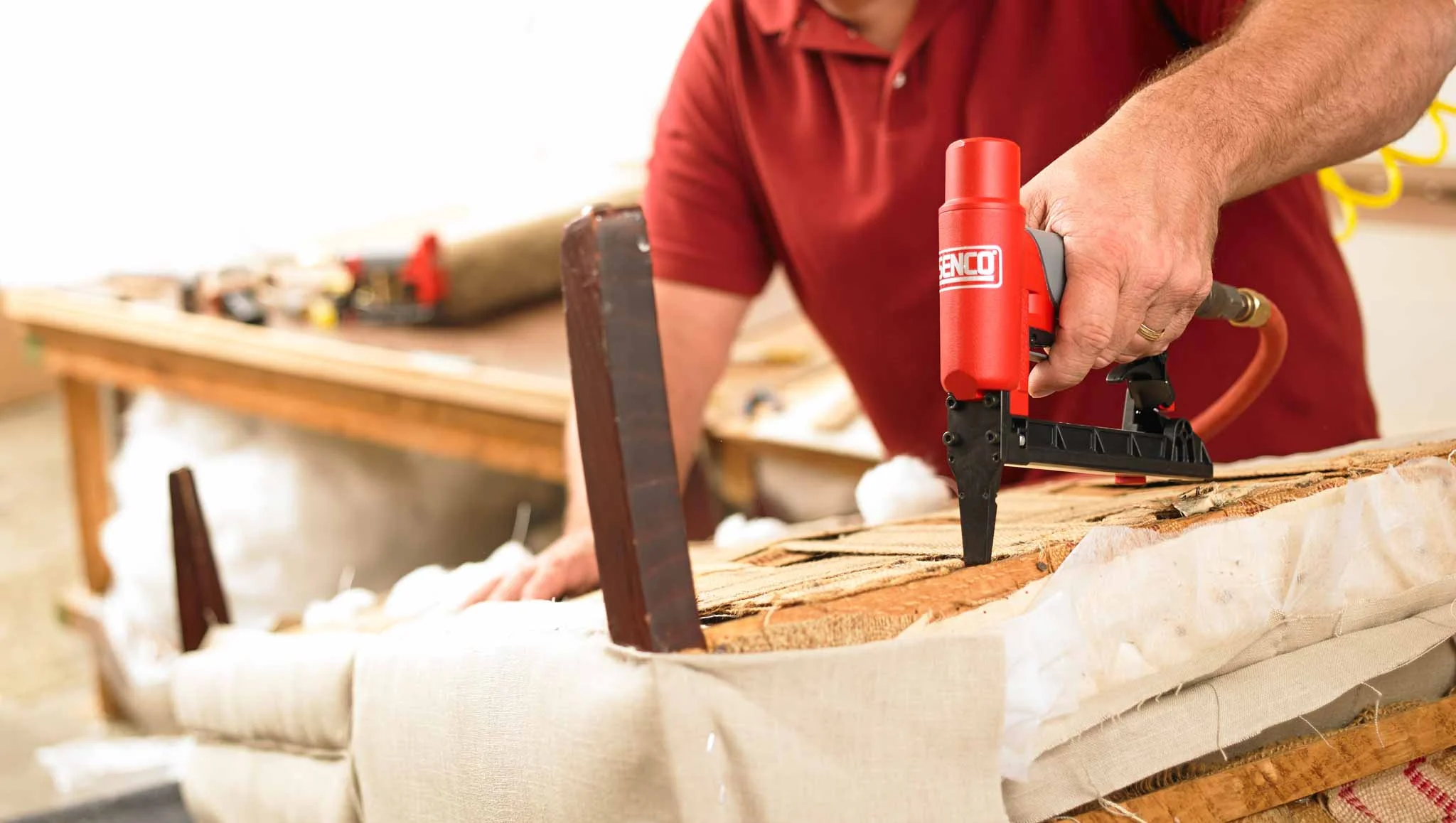What Kind of Upholstery Stapler Do I Need?

Whether you’re replacing a single seat covering, expanding your side hustle, or working on a high-volume production line, the type of stapler you use directly impacts the quality and efficiency of upholstery projects. There are many kinds of upholstery staplers to choose from, such as manual and electric. However, the power and reliability of pneumatic staplers make them the best upholstery stapler option, regardless of your level of expertise.
Types of Upholstery Staplers
Manual Upholstery Staplers
Manual staplers are affordable and intuitive to use. They are powered by springs and your grip strength, making them portable and convenient for small-scale DIY and craft projects using soft wood.
However, as the least powerful option, these staplers can struggle in dense wood, fabric folds, or thick foam and padding. Often, staples won’t sink all the way—keep a hammer and pliers handy to finish driving staples or remove them if they are bent or misplaced.
There are additional drawbacks:
- Manual staplers require considerable hand strength, leading to fatigue in the wrist and palm.
- The stapler may jump or slide out of position as you put downward pressure on the trigger, reducing accuracy and wasting staples.
- These staplers are slower than any other option, making them a poor choice for medium- to high-volume work, such as an upholstery shop or an assembly line.
Electric Upholstery Staplers
Electric staplers, either corded or battery-powered, offer more power and better consistency than manual models, making them a step up for home users. They are faster, easier to use, and overall better for medium-duty projects than manual staplers.
However, they still have limitations:
- They can be bulkier and difficult to maneuver. They lack the precision nose pieces of pneumatic staplers, limiting firing angles and staple placement.
- While more powerful than manual staplers, they are typically less powerful than pneumatic staplers, and they may struggle with thick materials, folds, or hardwood.
- Electric staplers may require time to ramp up, causing a delay between pulling the trigger and shooting the staple, slowing down projects.
Pneumatic Upholstery Staplers
Pneumatic staplers use compressed air to drive staples quickly and accurately. These are the best choice for professionals and serious DIYers, but even hobbyists benefit from extra reliability, power, and precision. Pneumatic staplers are powerful enough to drive into any material. The trigger mechanism requires almost no effort, reducing hand strain. They fire as quickly as you can pull the trigger, making short work of even big projects.
However, there are several things to consider:
- Pneumatic staplers may require oiling. Look for oilless staplers or SENCO’s NeverLube technology to minimize or eliminate maintenance.
- While pneumatic staplers are as affordable as electric ones, your total cost can increase if you don’t already have a compressor.
Getting Started as a Beginner
For starters, if you don’t already own an air compressor, you will want to purchase one along with your stapler. While this may seem like an extra investment, owning an air compressor provides a world of convenience and efficiency, especially if you have use for other pneumatic tools like nail guns, impact wrenches, or paint sprayers. They’re also useful for refilling tires, dust removal, and more.
Other equipment you may need includes hoses, safety gear, tool oil, and couplings. You’ll want to familiarize yourself with the tool, learning how to refill the magazine, clear jams, and perform basic maintenance. Additionally, make sure you know how to operate pneumatic tools safely before you get started.
Choosing the Right Staples
Upholstery staples are small, fine-wire staples designed to hold fabric, padding, or webbing onto furniture frames. They come in different sizes, with the most common being 20-22 gauge (which refers to the thickness of the staple wire) and various lengths (which determine how deep they go into the material).
The most common upholstery staple lengths range from 1/4 inch (6mm) to 5/8 inch (16mm). Here’s a general guide:
- 1/4 inch (6mm) – Best for delicate fabrics and thin materials.
- 3/8 inch (10mm) – A versatile size, good for most upholstery fabrics and light padding.
- 1/2 inch (12mm) – Works well for thicker fabrics, vinyl, and multiple layers of material.
- 5/8 inch (16mm) – Ideal for heavy-duty upholstery, leather, and securing thick padding.
Choosing the right staple length depends on the thickness of your fabric and the hardness of the wood frame. If the staple is too short, it won’t hold securely; if it’s too long, it could go through the wood or be difficult to drive in fully.
Be sure to use stainless steel staples for outdoor projects to prevent rust.
In conclusion, choosing the right upholstery stapler depends on your specific project needs, material type, and level of experience. Whether you opt for a manual, electric, or pneumatic stapler, each has its advantages in terms of power, ease of use, and precision. If you’re working on small DIY projects, a manual or electric stapler may be sufficient, while professionals and frequent users may benefit from the power of a pneumatic stapler. By considering factors such as staple size, compatibility, and ergonomics, you can ensure a smooth and efficient upholstery experience.
No matter your choice, investing in the right tool will make your project easier and deliver professional-quality results.

